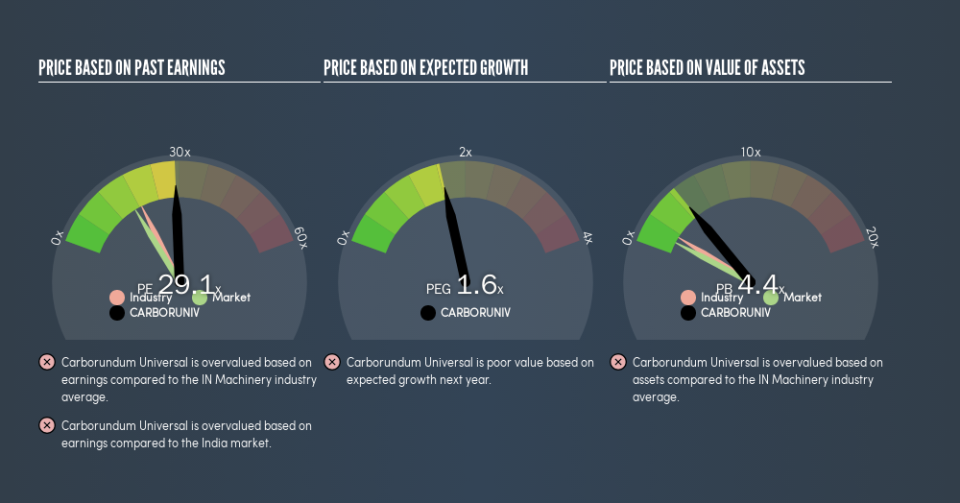Should We Worry About Carborundum Universal Limited’s (NSE:CARBORUNIV) P/E Ratio?

The goal of this article is to teach you how to use price to earnings ratios (P/E ratios). To keep it practical, we’ll show how Carborundum Universal Limited’s (NSE:CARBORUNIV) P/E ratio could help you assess the value on offer. Carborundum Universal has a price to earnings ratio of 29.06, based on the last twelve months. That corresponds to an earnings yield of approximately 3.4%.
Check out our latest analysis for Carborundum Universal
How Do I Calculate Carborundum Universal’s Price To Earnings Ratio?
The formula for P/E is:
Price to Earnings Ratio = Price per Share ÷ Earnings per Share (EPS)
Or for Carborundum Universal:
P/E of 29.06 = ₹386.7 ÷ ₹13.31 (Based on the trailing twelve months to December 2018.)
Is A High Price-to-Earnings Ratio Good?
A higher P/E ratio means that buyers have to pay a higher price for each ₹1 the company has earned over the last year. That isn’t a good or a bad thing on its own, but a high P/E means that buyers have a higher opinion of the business’s prospects, relative to stocks with a lower P/E.
How Growth Rates Impact P/E Ratios
Probably the most important factor in determining what P/E a company trades on is the earnings growth. That’s because companies that grow earnings per share quickly will rapidly increase the ‘E’ in the equation. That means even if the current P/E is high, it will reduce over time if the share price stays flat. Then, a lower P/E should attract more buyers, pushing the share price up.
Carborundum Universal increased earnings per share by a whopping 29% last year. And earnings per share have improved by 21% annually, over the last five years. So we’d generally expect it to have a relatively high P/E ratio.
How Does Carborundum Universal’s P/E Ratio Compare To Its Peers?
We can get an indication of market expectations by looking at the P/E ratio. You can see in the image below that the average P/E (18.9) for companies in the machinery industry is lower than Carborundum Universal’s P/E.
Its relatively high P/E ratio indicates that Carborundum Universal shareholders think it will perform better than other companies in its industry classification. Shareholders are clearly optimistic, but the future is always uncertain. So investors should always consider the P/E ratio alongside other factors, such as whether company directors have been buying shares.
Remember: P/E Ratios Don’t Consider The Balance Sheet
The ‘Price’ in P/E reflects the market capitalization of the company. Thus, the metric does not reflect cash or debt held by the company. Hypothetically, a company could reduce its future P/E ratio by spending its cash (or taking on debt) to achieve higher earnings.
Spending on growth might be good or bad a few years later, but the point is that the P/E ratio does not account for the option (or lack thereof).
Carborundum Universal’s Balance Sheet
Since Carborundum Universal holds net cash of ₹704m, it can spend on growth, justifying a higher P/E ratio than otherwise.
The Verdict On Carborundum Universal’s P/E Ratio
Carborundum Universal has a P/E of 29.1. That’s higher than the average in the IN market, which is 16.6. With cash in the bank the company has plenty of growth options — and it is already on the right track. So it is not surprising the market is probably extrapolating recent growth well into the future, reflected in the relatively high P/E ratio.
When the market is wrong about a stock, it gives savvy investors an opportunity. If the reality for a company is better than it expects, you can make money by buying and holding for the long term. So this free report on the analyst consensus forecasts could help you make a master move on this stock.
Of course, you might find a fantastic investment by looking at a few good candidates. So take a peek at this free list of companies with modest (or no) debt, trading on a P/E below 20.
We aim to bring you long-term focused research analysis driven by fundamental data. Note that our analysis may not factor in the latest price-sensitive company announcements or qualitative material.
If you spot an error that warrants correction, please contact the editor at editorial-team@simplywallst.com. This article by Simply Wall St is general in nature. It does not constitute a recommendation to buy or sell any stock, and does not take account of your objectives, or your financial situation. Simply Wall St has no position in the stocks mentioned. Thank you for reading.


